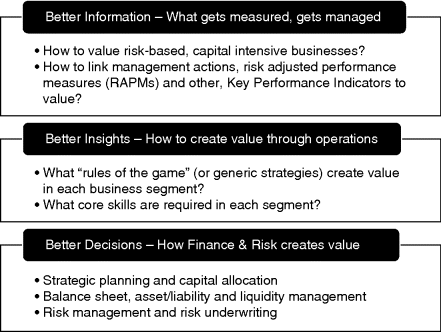Part OneIntroduction
Chief Financial Officers (CFOs) and Chief Risk Officers (CROs) have significant potential to influence the value of their firm through three channels.
- First, by providing better information in the form of Risk-Adjusted Performance Metrics (RAPMs), which link management actions directly to shareholder value.
- Second, by challenging businesses to higher levels of performance through better insights, including segment-specific strategies and management actions.
- Third, by taking better decisions in their own areas of responsibility, especially corporate strategy and capital allocation, balance sheet management and risk management.
These three levers are so important for managing the value of banks and insurers that they form the organizing framework for this Handbook, illustrated in the figure below.

Figure P1.1 Managing for value from the finance and risk perspective
These responsibilities are also relatively new, representing an evolution in the roles of the CFO and CRO over the past 20 to 30 years. As banks and insurance companies evolved into larger, more complex, internationally diversified financial services groups, the roles of the CFO and CRO evolved in parallel. The result is a finance and risk “backbone” that helps diversified groups get the most from their corporate portfolio through strategic planning, performance management, capital allocation ...
Get Value and Capital Management: A Handbook for the Finance and Risk Functions of Financial Institutions now with the O’Reilly learning platform.
O’Reilly members experience books, live events, courses curated by job role, and more from O’Reilly and nearly 200 top publishers.

